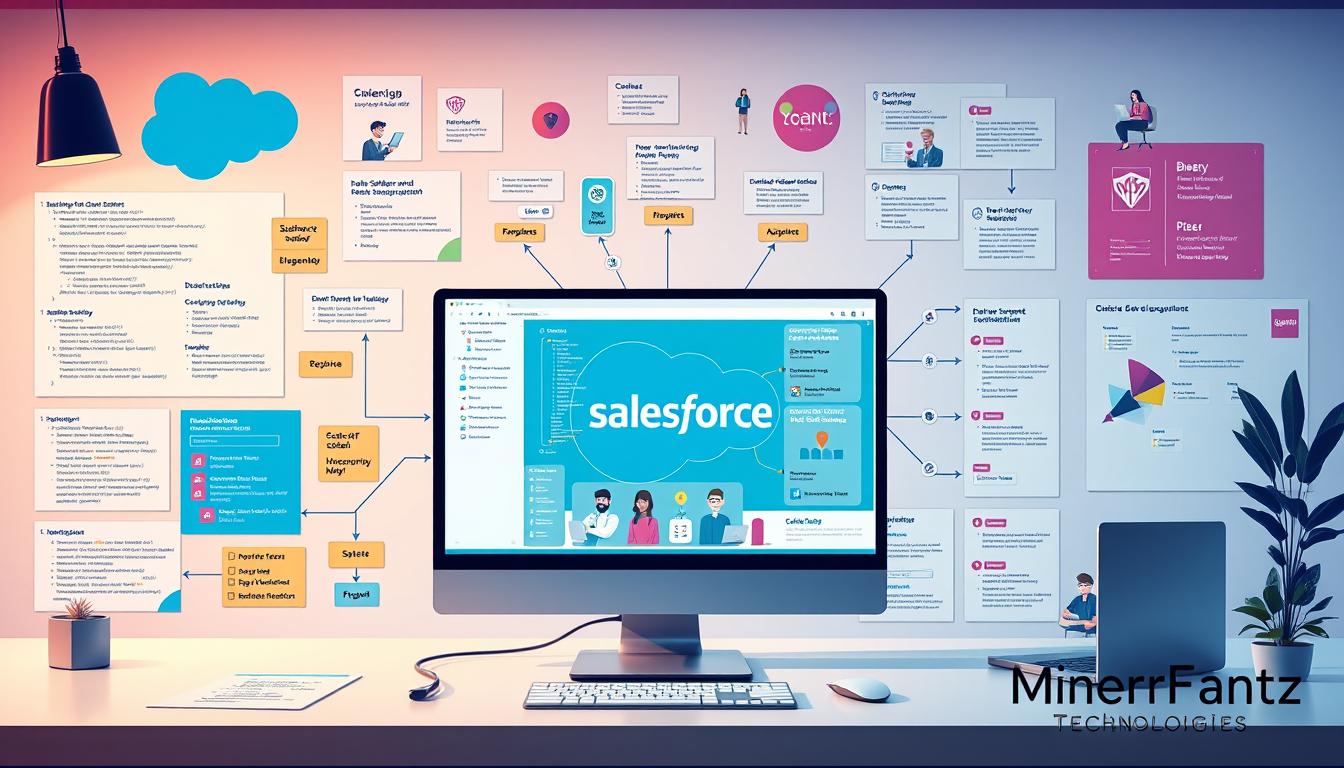
When I started a complex Salesforce project, I hit a snag. We didn’t have clear documentation. A small bug turned into a two-day headache. We spent hours trying to find the problem because we didn’t document our steps.
It made me realize how crucial Salesforce Development Documentation is. If we had documented our process, we could have fixed the issue quickly. Without it, we risked losing valuable knowledge and facing future challenges.
Many of you might have had similar experiences. The rush to understand past decisions, the stress of deadlines, and the relief of good documentation. It’s not just about what we’ve done. It’s about building a solid base for teamwork, training, and adapting to business changes.
With the right Salesforce Best Practices, each document becomes a key tool in our work. It helps us grow and improve together.
Key Takeaways
- Good documentation helps solve problems faster.
- Recording the “how and why” makes future updates easier.
- Proper documentation allows for the effective reuse of existing solutions in new contexts.
- Highlighting the business needs and tools utilized adds significant value to documentation.
- Meticulous documentation reduces the risks associated with employee turnover.
- Effective documentation simplifies knowledge transfer across team members.
- Clear process documentation can visualize elements crucial for project success.
The Importance of Salesforce Development Documentation
Understanding the importance of Salesforce development documentation is key to project success. Good documentation helps avoid knowledge gaps and records important decisions. This makes sure everyone knows what’s going on and helps new team members learn fast.
When documentation is clear and easy to find, teams solve problems quicker. This means they can focus more on creating value.
It’s important to regularly check and update documentation to keep it current. Tools like ApexDoc and Elements.cloud help make this easier. Using the same naming and formatting helps make documentation better.
Teams should start documenting early and keep going throughout the project. This saves a lot of time and effort later on. When everyone helps with documentation, it captures important knowledge and helps teams work better together.
Good documentation practices also improve data quality by helping enter and keep data right. Investing in Salesforce Development Resources, like a centralized documentation standard, helps follow best practices. This leads to better work efficiency and smoother integration with systems like Service Cloud.
Faster Troubleshooting with Quality Documentation
In the world of Salesforce development, quality documentation is key. It helps a lot when I’m troubleshooting. A detailed Salesforce API Reference is a great place to start. It lets me follow through configurations and rules, making sense of them.
Helpful descriptions for custom fields make a big difference. They improve user understanding and data accuracy. This leads to better data quality, making it easier to find issues.
Keeping change logs is also important. They help track changes and their effects. This approach, following Salesforce Coding Standards, lowers the chance of errors. With tools like Salesforce Knowledge and Chatter, I can quickly find important documents.
Good documentation is like a roadmap for users. It helps me navigate complex processes. This makes troubleshooting faster and more effective. The time saved lets me focus on strategic tasks.
Knowledge Transfer and Onboarding New Team Members
Onboarding new team members is key to success. Effective documentation plays a big role. With Salesforce, a detailed guide helps new hires get started quickly. They learn about projects and our workflows fast.
The Role of Documentation in Reducing Ramp-Up Time
Getting new team members up to speed quickly is crucial. Our Salesforce Best Practices help them start working right away. They ask fewer questions and contribute more to projects.
This lets current team members focus on their tasks. It makes our work environment efficient and productive.
Building a Self-Service Resource for New Hires
A self-service resource helps new hires learn on their own. They can find the answers they need anytime. This reduces the need for constant guidance and encourages self-learning.
New employees can dive into training materials easily. They gain valuable insights, making their transition smoother.
Reducing Risks and Errors During Development
Quality documentation is key to avoiding risks and errors in development. When I make detailed Salesforce Development Documentation, I make sure everything is clear. This helps the team understand the impact of changes before they happen.
Looking back at documented decisions helps my team avoid past mistakes. This boosts our efficiency and makes our products more reliable. Following Salesforce Best Practices helps us avoid errors that could harm business operations.
Effective data management is also crucial. It ensures data stays safe, secure, and easy to access. This is vital during development.
Using Salesforce Developer Sandboxes lets us test without affecting the business. This hands-on experience improves our software quality. Adopting DevOps practices also makes us more productive and saves money.
Sticking to Salesforce Development best practices improves teamwork and workflow. My aim is to reduce delays and make apps work better. Detailed documentation not only protects my project but also sets us up for future success.
Improved Collaboration Among Salesforce Teams
Effective documentation is key for teamwork in Salesforce. When everyone can access the same Salesforce Development Resources, sharing knowledge gets easier. This leads to a place where team members can learn from each other, cutting down on confusion and speeding up our response to problems.
Centralized Knowledge Sharing
A single Salesforce Documentation Repository makes sharing knowledge simpler. Developers and admins can talk more clearly and solve issues faster. It also helps new admins get up to speed quickly, making them productive right away.
Fostering a Cohesive Team Environment
A good documentation system helps solve new challenges by reusing old solutions. It also finds ways to improve existing ones with new features. Customizing our documentation in Salesforce gives us specific resources that meet our needs. As our business grows, so can our documentation, keeping up with our changing needs.
Enhanced Efficiency Through Easily Accessible Resources
Good documentation is key for Salesforce development teams to work better. When I have all the Salesforce Development Documentation in order, I can find what I need fast. This saves time and lets me do my main tasks without delay.
Following Salesforce Best Practices helps keep our resources tidy. This makes it easier for everyone to find what they need. For instance, with d.velop connect, I can easily get to important documents. This cuts down on mistakes by reducing the need to jump between different systems.
Using Salesforce Flow to automate documents makes things simpler. It makes our work more consistent and efficient. This way, we can work better together. Having all documents in one place in Salesforce helps us avoid information gaps.
This setup also makes our work flow smoother. It helps teams work together faster, leading to quicker decisions. Plus, d.velop connect’s cost-effective storage options help avoid wasting money on storing too many documents. Using these tools makes our Salesforce development team more productive and successful.
Understanding Dependencies Through Salesforce Development Documentation
Managing dependencies in Salesforce can be tough, especially with more configurations and automations. It’s key to document these dependencies well. This helps us see how different parts of Salesforce work together.
Knowing how objects and fields connect is vital. It lets architects and analysts make better choices. They can understand metadata relationships, data flow dependencies, and logical dependencies more clearly.
Changes in how objects are set up can really affect data and business work. Seeing these dependencies helps make smart decisions. It’s also important to know how users interact with metadata.
Tools like Elements.cloud help show dependencies clearly. This makes it easier to decide and work on Salesforce projects. Good documentation is crucial for better work and processes, as the Salesforce Developer Guide shows.
Field Utilization Tracking for Better Data Quality
Tracking how fields are used is key to keeping data quality high in Salesforce. I’ve found that looking at metrics like the percentage of records updated recently is crucial. It shows where we need to focus to improve data quality.
By checking how data compares to trusted sources, I can spot and fix errors. It’s vital to ensure consistency in fields like dates, currencies, or states. This makes our reports reliable.
Using Salesforce’s Duplicate Management tools is essential for clean data. These tools find and manage duplicate records. Validation rules also help by checking if all necessary field values are correct.
Continuously refining our Salesforce Best Practices for data quality is important. Each industry has its own needs, so customizing these rules is crucial. Tools like Salesforce Optimizer help us use our data better and improve documentation.
By focusing on user-friendly features and data quality, I see big benefits. Monitoring data quality helps us make better decisions and gives users a better experience. Accurate data entry and management are key to this.
Process Visualization and its Impact on Business Processes
In my experience, Salesforce Development Documentation makes complex workflows clear. At Ursa Major Solar, we’ve found that combining customer data across sales, service, and marketing is key. Our team, including the Salesforce solution architect, business analyst, and admin, works together to improve our customer focus.
By integrating different roles, we can see the whole journey from lead to revenue to service. We use Salesforce Development Resources to create detailed diagrams. These diagrams are based on the UPN standard and make our processes easy to understand.
In live workshops, we get feedback from stakeholders. This is better than using questionnaires or interviews alone. It helps us come up with new ideas and spot problems.
We also teach the importance of accurate data entry. Quick or careless data entry can harm our data quality. By explaining why each process is important, we improve both data quality and efficiency.
Documenting our business processes is more than just a rule. It helps us collect quality data. This is crucial as we use AI tools that need accurate data to make smart decisions.
Keeping Documentation Up-to-Date as Your Business Grows
As I explore the changing world of business and tech, I see how important it is to keep Salesforce Development Documentation current. Companies grow and change, and their documents must keep up. Regular updates make sure everything matches the latest business practices and setups.
Ignoring this can cause valuable knowledge to be lost. This loss can hurt productivity.
Studies show that sales reps spend a lot of time looking for answers. They spend 3-11 hours a week on this. Sales leaders also spend over four hours answering questions because of bad or old documentation. This shows how important clear and up-to-date Salesforce Best Practices are.
When documentation is not a priority, it often gets ignored. This creates a big problem for how well things work.
It’s hard to keep up with fast-changing processes. Without regular updates, people might use chat platforms instead. This might seem easy, but it misses the point of good documentation.
Good documentation has three key things: Completeness, Clarity, and Consistency. Keeping these in mind makes things easier for users.
Using tools like Spekit can make things easier. It offers short, simple content that fits different learning styles. Adding this content to daily routines helps users learn and remember better.
As I work to make Salesforce workflows better, using AI for documentation is helpful. It keeps information current, leading to better efficiency and productivity.
Leveraging AI for Effective Documentation
Using AI in Salesforce development documentation is exciting. It makes processes better and outcomes more effective. AI tools help teams keep their documentation up to date, making it more efficient and effective.
How AI Tools Aid Documentation Maintenance
AI tools can automate many parts of documentation. This includes creating and updating content, keeping it accurate and relevant. By using AI, we can make our documentation more reliable.
Training AI with CRM data helps improve customer service. It also supports better decision-making. This lets employees focus on important tasks, not just routine ones.
The Future of Salesforce Development Documentation with AI
AI technology is getting better, offering deeper insights and smarter knowledge management. It’s important to set up security controls and teach teams about AI ethics. We must also address privacy and bias in AI models to build trust.
Creating diverse teams for risk reviews is key. This ensures AI is fair and respects all stakeholders. With AI, the future of Salesforce documentation looks bright, promising better resources and easier use.
Salesforce Best Practices for Effective Documentation
Following Salesforce Best Practices for documentation is key for any team. I start by standardizing formats. This makes documents clear and easy to follow.
Keeping a metadata dictionary is also vital. It helps everyone understand project-specific terms. Tools like Confluence by Atlassian greatly improve documentation.
It’s important to know who updates the documentation. This keeps everyone on the same page and ensures information stays current.
Using platforms for teamwork helps everyone contribute. Tools like CloudConverter by Model Metrics and Octopus make managing resources easier. The goal is to keep all information in one place.
It’s crucial to explain each field clearly. This helps both current and future users. I focus on documenting key business processes first.
An Administrator’s Handbook is essential. It keeps things running smoothly and helps manage technical debt. It also explains past decisions that affect future work.
Clear and simple documentation is key. Visual aids like diagrams help people understand complex info better. I use Universal Process Notation (UPN) for clear visuals.
Regular reviews and feedback are important. They make our documentation better and help the development process.
Conclusion
Effective Salesforce development documentation is a game-changer for any organization using the platform. Statistics show that 60% of successful projects rely on clear communication and documentation. This isn’t just a task—it’s a way to improve teamwork and efficiency.
Following Salesforce best practices in documentation also helps manage risks and boosts user satisfaction. The right documents, like user stories or gap analysis, guide development. They help us tackle technical debt more effectively.
Investing in documentation processes is key to our future success. It helps us adapt to changes in the Salesforce ecosystem. By focusing on quality documentation and updates, we stay agile and informed. This paves the way for our projects to advance.
See how FieldAx can transform your Field Operations.
Try it today! Book Demo
You are one click away from your customized FieldAx Demo!
FAQ
Why is documentation important in Salesforce development?
How does effective documentation improve troubleshooting?
What role does documentation play in onboarding new team members?
How does documentation reduce risks and errors?
How does documentation foster collaboration among Salesforce teams?
What are the benefits of easily accessible documentation?
Why is mapping dependencies essential in Salesforce documentation?
How can tracking field utilization improve data quality?
What is the significance of process visualization in Salesforce?
How can organizations keep their documentation up-to-date?
How do AI tools aid in documentation maintenance?
What are some best practices for effective Salesforce documentation?
Author Bio
Co-Founder & CMO at Merfantz Technologies Pvt Ltd | Marketing Manager for FieldAx Field Service Software | Salesforce All-Star Ranger and Community Contributor | Salesforce Content Creation for Knowledge Sharing





